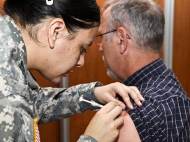Vaccine based on gold nanorods for respiratory syncytial virus
 A team of researchers at the Vanderbilt University has devised a new vaccination method that uses tiny gold particles to mimic a virus and carry specific proteins to the body’s specialist immune cells. Unlike the conventional approach to vaccines, the new technique does not use inactive or dead viruses during the vaccination process, thus eliminating the chances of infection.
A team of researchers at the Vanderbilt University has devised a new vaccination method that uses tiny gold particles to mimic a virus and carry specific proteins to the body’s specialist immune cells. Unlike the conventional approach to vaccines, the new technique does not use inactive or dead viruses during the vaccination process, thus eliminating the chances of infection.
The research team has demonstrated this method in the lab using a specific protein that sits on the surface of the respiratory syncytial virus (RSV). RSV is a major cause of lower respiratory tract infections, mainly in children and the elderly. A specific protein, called F protein, coats the surface of the virus and it is partly responsible for the harmful effects of RSV. This protein enables the virus to enter into the cytoplasm of cells and also causes cells to stick together, making the virus harder to eliminate.
Therefore, the cell’s natural defense to RSV virus targets the F protein. So far, scientists couldn’t make a vaccine that will deliver the F protein to the specialized immune cells. When targeted right, F protein could trigger an immune response which the body could remember if the patient becomes infected with the real virus.
The research team created tiny gold nanorods, in almost exactly the same shape and size of the virus itself. These nanorods were coated with the RSV F proteins and were bonded strongly. They tested the ability of the nanorods to deliver the F protein to specific immune cells called dendritic cells – immune cells whose main function is to process antigen material and present it on the surface to other cells of the immune system such as T cells. Dendritic cells take the valuable information from a virus, such as the F protein, and present it to cells that fight against viruses.
When the protein-coated nanorods were added to a sample of dendritic cells, the proliferation of T cells was analyzed. It was shown that protein-coated nanorods caused the proliferation of T cells notably more when compared to both non-coated nanorods and F protein alone. F protein-coated nanorods were able to mimic the virus and stimulate an immune response. Additionally, gold nanorods didn’t exhibit toxic effects on human cells, and the researchers believe that their potential use is not limited to RSV.
“This platform could be used to develop experimental vaccines for virtually any virus, and in fact other larger microbes such as bacteria and fungi. The studies we performed showed that the candidate vaccines stimulated human immune cells when they were interacted in the lab. The next steps to testing would be to test whether or not the vaccines work in vivo”, said James Crowe, professor at Vanderbilt University.
For more information read the article published in IOP Publishing’s journal Nanotechnology: “Gold nanorod vaccine for respiratory syncytial virus“.









Leave your response!